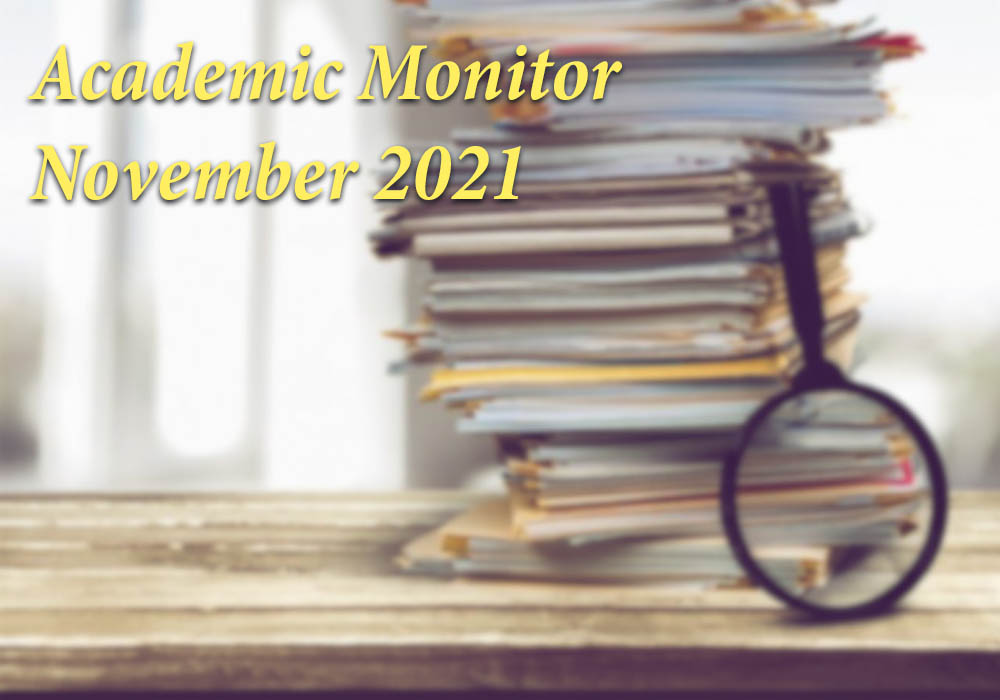Throughout November, China-Central Asia relations were analyzed from different perspectives. Despite the Belt and Road Initiative (BRI) being one of the main themes, some new nuances of the enterprise were unveiled along with new interesting themes such as the Chinese soft power and its relations with education; the challenges to China-Central Asia relations imposed by foreign actors and international agreements; the development of the economic corridors within the BRI; and the role of the Shanghai Cooperation Organization (SCO) as a security provider.

An important topic covered by different works is that of China’s soft power and its expansion in Central Asia’s educational system. According to Mirzaakhmedova Dilsora, due to similar historical experiences shared by all five Central Asian countries, the region now presents some linguistic similarities. However, when it comes to foreign language educational programs, such a commonality no longer exists. As mentioned by the author, plans for language education differ in each of these countries due to the different conditions of each nation to invest in such a field. In this context, China has been increasing its presence in the region as a promoter of foreign language education, which has been promoting Chinese soft power through Central Asia and enhancing the region’s knowledge of different idioms. However, as mentioned by Khodzhimuratova, China is not the only player striving to increase its presence in Central Asia through education. Iran has also been engaging with similar policies aimed at improving foreign language education among all five nations, though their research is rather concentrated on Kyrgyzstan.
Notwithstanding, China’s relations with Central Asia are not limited to education and are not rivaled by Iran only. As argued by Muhammad Nadeem Mirza and Shaukat Ayub, Russia is the international actor that poses the most important challenges to China in the midst of its expansion through the region, which raises questions regarding the dynamics of Sino-Russian relations in Central Asia. With the signing of several lucrative deals on oil, gas, currency, and other bilateral and multilateral arrangements, Sino-Russian relations over the last three decades have reached unprecedented levels. However, as China began to translate its economic influence in Central Asia into a political one, Russia started feeling uneasy about losing its traditional sphere of influence in its ‘Near Abroad.’ Despite the apparent conflictual positions between both players, the authors suggest that China and Russia have adopted the policy of competitive collaboration – cooperation where there exists convergence and competition when it comes to divergence of interests – in Central Asia.
The uncertain, and maybe ambiguous, harmony established between Russia and China in Central Asia is not the only source of doubts regarding the future of the region and its relations with Shanghai. Ksenia Kirkham draws our attention to the role of the Chinese goals regarding carbon emissions in the country’s presence in Central Asia. Xi Jinping announced China’s goal to achieve carbon neutrality by 2060. These strategic goals are in line with China’s international commitment to ‘global climate action’ under the 2016 Paris Accords. These plans go in stark contrast with rising investment in pipeline projects in Central Asia and the South Caucasus that compete with Russia’s expanding transit capacities and with the dramatic development of LNG markets in Europe and Asia. The New Great Game seems to have been turning 180°—from rivalry among consumers over upstream assets and transportation routes in Central Asia and the South Caucasus towards competition between producers over sales markets in Europe and China, although the recent and sudden global gas supply crisis suggests a more complicated picture.
Another threat to the sustainability and continuity of Chinese projects regarding Central Asia is terrorism. In the context of the China- Central Asia-West Asia economic (CCAWAEC) corridor, part of BRI, Dilesha Rathnayake investigates the effect of terrorism on bilateral trade with China and on foreign direct investment (FDI) flows from China to the region. The author hypothesizes and provides macroeconomic evidence that there is a negative relationship between terrorism and trade on CCAWAEC - the greater the threat of terrorist events and/or the higher the possibility of the presence of terrorist organizations, the lower the level of investments. The study was further extended to look at FDI, but no clear evidence was found between terrorism and FDI stocks from China to the countries of the corridor. Li Sheng and Dmitri Felix do Nascimento, though from a different perspective, also analyze economic corridors under the BRI. The authors review the development panorama of the BRI and its six economic corridors: The China–Mongolia–Russia Economic Corridor (CMREC, the New Eurasian Land Bridge (NELB), the China–Central Asia–West Asia Economic Corridor (CCWAEC, the China–Indochina Peninsula Economic Corridor (CIPEC), the China–Pakistan Economic Corridor (CPEC and Bangladesh–Chinese–India–Myanmar Economic Corridor (BCIMEC).
Finally, Lucas Gualberto do Nascimento suggests the impacts of the Sino-Kazakh relations towards water management under the SCO. In recent years, Chinese water diplomacy towards Kazakhstan has advanced in different agreements that are shaping the patterns of water security in Central Asia. The Chinese strategic interest in the development of the scope of the SCO in this region has allowed Kazakh transboundary water issues to advance in negotiations. However, these agreements have been made in a bilateral scheme, which is considered relatively unequal towards Kazakh interests; therefore, in spite of the Kazakh efforts, the SCO so far has not turned into a water security organization. From the perspective of the critical geopolitics scholarship and its considerations regarding the concepts of hegemony and zones of influence, the author supports the idea that the Sino-Kazakh cooperation has advanced following Chinese interests. In conclusion, it is argued that due to the lack of interest in Chinese water diplomacy, and despite of Kazakh efforts, the SCO is not in the near future launching great initiatives regarding water security in the region, reinforcing the Chinese diplomacy of bilateral water agreements.

